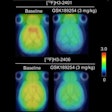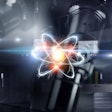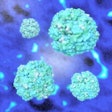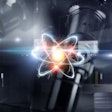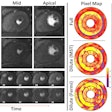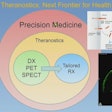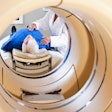ST. LOUIS - Calling it the best of all worlds, researchers at Case Western Reserve University in Cleveland have developed a fully automated 3-D co-registration system for CT, MRI, and SPECT images that accurately displays the anatomical structure and metabolic activity of prostate cancer.
"Prostate cancer is a very feared disease. It's a very common disease, but imaging modalities have had a poor time looking at patients in the early stages," said Dr Bruce Sodee.
"The patients either receive surgery -- prostatectomy -- or radiation therapy in two forms, one being brachytherapy." Through these alternatives, Sodee said, "approximately 60% of the patients are cured. That means that we have a way to go to target that disease."
Sodee and his co-authors presented the results of their study at the Society of Nuclear Medicine conference on June 4. The two key elements of their registration system are ProstaScint, a 111-Indium-labeled monoclonal antibody developed by Cytogen of Princeton, NJ, and a concept called mutual information (MI), or the relative entropy between two volumes to determine the best alignment.
The need for co-registered images became particularly clear after Sodee and his team began working with brachytherapists and wanted a more specific way to target cancer treatment, he said.
Researchers at the University of Chicago had already devised a successful 3-D registration scheme between CT and SPECT for the pelvis; however, it was a dual-energy, multistep, manual procedure (J Nucl Med, Feb.1999, Vol. 40:2, pp.347-351).
But the MI system requires no pre-processing because no specific relationship between image intensity values between the two volumes is assumed. Other registration systems may still require some preparation, such as cropping the background to make it easier to read the image, said Dr. Zhenghong Lee, Sodee's co-author.
"With our system, the images are just loaded into the computer automatically and adjusted, which cuts down on the human involvement and error," Lee said.
In this study, MR sequences that had already diagnosed prostate cancer were used. SPECT images of different patients, including recently diagnosed and post-therapy patients, were reconstructed using ordered subset expectation-maximization (OSEM) for registration. The MI between the two scans was estimated with a histogram distribution. Anatomic landmarks were used to verify the automatic registration. The required post-adjustment was one to two image pixels in translation and about 1º in rotation.
The results were more robust, precise images that defined metastatic disease and tracked the cancer if it had spread, said Sodee.
"What we did was assign the prostate a light green color. The cancer is red," Sodee explained while describing one of the co-registered images. "It's simplistic but it's real. What you are looking at is a cancer in the right lobe that's spread to the seminal vesicles."
This information can be used by radiation therapists and urologists as a guide for treating cancer that has extended beyond the prostate bed, Sodee said.
Sodee and his team also presented the results of two other studies related to prostate cancer. In one, they tested the sensitivity of ProstaScint in a three-year retrospective survey of 2,290 scans taken at 15 imaging centers. According to the results, the centers that used an acquisition matrix of 128 x 128 had sensitivity of more than 90%, while images acquired at 64 x 64 had a sensitivity of less than 70%.
In a third study, the group compared FDG-PET to ProstaScint for staging prostate carcinoma. They found that ProstaScint was better for showing the extent of the disease, while FDG-PET was well suited for determining how aggressive the disease was.
However, the authors acknowledged that ProstaScint still has drawbacks, including a major time commitment. Up to four hours of camera time is still necessary for one exam, Sodee said.
Fine-tuning the process and co-registration software to reduce the imaging time is in the works, Lee added. Once that has taken place, other facilities should be able to duplicate the technique.
"You can't get much easier than automatic co-registration," Sodee said.
The co-registration system should have a profound effect on patient management, possibly reducing the number of prostatectomies that are performed if radiotherapy turns out to be a more viable option, commented Dr. Henry Wagner, past president of the SNM.
"In the United States every year, 50,000 patients have prostatectomies. The urological surgeons believe that their treatment works best," Wagner said. "In many cases, if the urologist knew the status of the patient before the operation -- that the disease had spread beyond the prostate capsule -- the patient would not be operated on, but treated with radiation or seed therapy."
By Shalmali Pal
AuntMinnie.com staff writer
June 6, 2000
Let AuntMinnie.com know what you think about this story.
Copyright © 2000 AuntMinnie.com






